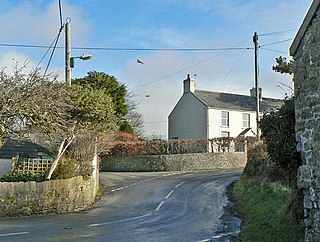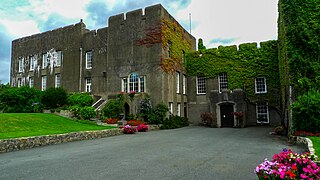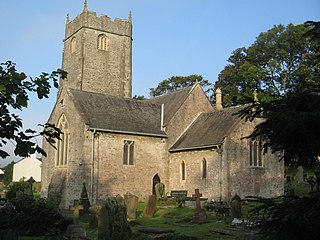
The Vale of Glamorgan, locally referred to as The Vale, is a county borough in the south-east of Wales. It borders Bridgend County Borough to the west, Cardiff to the east, Rhondda Cynon Taf to the north, and the Bristol Channel to the south. With an economy based largely on agriculture and chemicals, it is the southernmost unitary authority in Wales. Attractions include Barry Island Pleasure Park, the Barry Tourist Railway, Medieval wall paintings in St Cadoc's Church, Llancarfan, Porthkerry Park, St Donat's Castle, Cosmeston Lakes Country Park and Cosmeston Medieval Village. The largest town is Barry. Other towns include Penarth, Llantwit Major, and Cowbridge. There are many villages in the county borough.

Aberavon is a town and community in Neath Port Talbot county borough, Wales. The town derived its name from being near the mouth of the river Afan, which also gave its name to a medieval lordship. Today it is essentially a district of Port Talbot, covering the central and south western part of the town. Aberavon is also the name of the nearby Blue Flag beach and the parish covering the same area.

St Donat's Castle, St Donats, Wales, is a medieval castle in the Vale of Glamorgan, about 16 miles (26 km) to the west of Cardiff, and about 1+1⁄2 miles (2.4 km) to the west of Llantwit Major. Positioned on cliffs overlooking the Bristol Channel, the site has been occupied since the Iron Age, and was by tradition the home of the Celtic chieftain Caradog. The present castle's origins date from the 12th century when the de Haweys and later Peter de Stradling began its development. The Stradlings held the castle for four hundred years, until the death of Sir Thomas Stradling in a duel in 1738.

The Merthyr Rising, also referred to as the Merthyr Riots, of 1831 was the violent climax to many years of simmering unrest among the large working class population of Merthyr Tydfil in Wales and the surrounding area. The Rising marked the first times the red flag was used a symbol of working class rebellion in the United Kingdom.

The Diocese of Llandaff is an Anglican diocese that traces its roots to pre-Reformation times as heir of a Catholic bishopric. It is headed by the Bishop of Llandaff, whose seat is located at the Cathedral Church of Saint Peter and Saint Paul in Llandaff, a suburb of Cardiff. It currently covers most of the former Welsh county of Glamorgan, but once stretched from the River Towy to the middle of the Wye Valley.
Richard Lewis, known as Dic Penderyn, was a Welsh labourer and coal miner who lived in Merthyr Tydfil and was involved with the Merthyr Rising of 3 June 1831. In the course of the riot he was arrested alongside Lewis Lewis, one of the primary figures in the uprising, and charged with stabbing a soldier with a bayonet. The people of Merthyr Tydfil doubted his guilt, and signed a petition for his release. However, he was found guilty and hanged on 13 August 1831. After his death he was treated as a martyr in Merthyr and across Wales.

St Donats is a village and community in the Vale of Glamorgan in south Wales, located just west of the small town of Llantwit Major. The community includes the village of Marcross and the hamlets of Monknash and East and West Monkton. It is named after the 6th-century saint, Dunwyd, a friend of Saint Cadoc. It had a population of 732 in 2011.

Llanharan is a village and community in the county borough of Rhondda Cynon Taf, Wales. As a community Llanharan takes in the neighbouring settlements of Bryncae, Brynna, Llanilid, Peterston-super-Montem and Ynysmaerdy. Llanharan thrived during the British Industrial Revolution, with several tin and coal mines in the location providing employment to the town's residents. With the decline of heavy industry in the South Wales Coalfield, Llanharan has been in economic decline, though its proximity to the M4 motorway offers its residents easy commutable access to most of South Wales.

Marcross is a small village in the rural community of St Donats in the Vale of Glamorgan, south Wales. It consists of a public house and a few scattered houses, farms, and a small medieval church in the centre of the village.

Fonmon Castle is a fortified medieval castle near the village of Fonmon in the Vale of Glamorgan and a Grade I listed building. The castle's gardens are designated Grade II on the Cadw/ICOMOS Register of Parks and Gardens of Special Historic Interest in Wales. With its origins rooted in the 12th century it is today seen as a great architectural rarity, as it is one of few buildings that was drastically remodelled in the 18th century, but not Gothicized. The castle is believed to have remained under the ownership of just two families throughout its history; from Norman times, it was owned by the St Johns, and from 1656, by the descendants of Colonel Philip Jones.

John Prichard was a Welsh architect in the neo-Gothic style. As diocesan architect of Llandaff, he was involved in the building or restoration of many churches in south Wales.

Llanharan House is a historic house on the outskirts of Llanharan, Rhondda Cynon Taf, Wales. It is located off the A473 road, just east of Llanharan and is a Grade II* listed building. The gardens and park attached to the house are designated Grade II on the Cadw/ICOMOS Register of Parks and Gardens of Special Historic Interest in Wales.

Dimlands was a small scale, gentry house on the north side of St Donats Road about 6 miles (9.7 km) southwest of Cowbridge in the Vale of Glamorgan, southeast Wales. Built like a small Tudor castle, it is situated about 1 kilometre (0.62 mi) back from the clifftops of the Bristol Channel between Llantwit Major and St Donats. The main house was demolished after a fire in 1948, but its lodge, in a similar castellated style, survives and became a Grade II listed building on 9 October 1982.

Coity is a village in Bridgend County Borough, south Wales, part of Bridgend town urban area. Coity is part of the community of Coity Higher and is notable for being home to Coity Castle, one of the best-preserved castles in Glamorgan. Other buildings of note in the village include St Mary, a 14th-century church, and Ty Mawr, a fine 16th-century house.

Penderyn is a rural village in the Cynon Valley, Rhondda Cynon Taf, Wales, located near Hirwaun.

There are 33 Grade I listed buildings in the Vale of Glamorgan all of which are churches and priory buildings, castles, country or manor houses and associated structures such as churchyard crosses and a dovecote.

Welsh St Donats is a village and a community in the Vale of Glamorgan, Wales. Consisting of 1207 hectares of mainly rural land, it is located north east of Cowbridge. The population of the community was 534 in the 2011 census. Welsh St Donats includes the villages of Maendy, Prisk and Tair Onen. A mile to the east from the village lies the Hensol Forest, while the remains of Talyfan Castle are to the north.

The Church of St John the Baptist is a medieval church in Llanblethian in the Vale of Glamorgan, south Wales. Believed to have been built in the 12th century, the church boasts an unusual tower, consistent with the style more common in the south west of England. It underwent extensive restoration in the late 19th century, undertaken by C. B. Fowler of Cardiff. The Church of St John was listed as a Grade I building on 22 February 1963.

St Donat's Church is a Grade I listed church in St Donats, in the Vale of Glamorgan, south Wales. It became a Grade I listed building on 22 February 1963.
David Montgomery Vaughan (c.1810–c.1892) was a Welsh architect, surveyor, land agent and diarist.



















